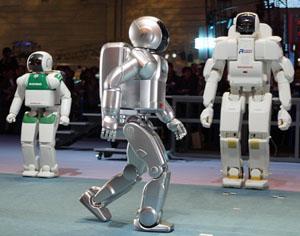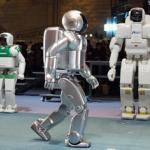Japanese scientists want to make robots part of the family
YOKOHAMA, Japan, April 3, 2003 - Japanese scientists are trying to make robots part of the family rather than automated servants -- by improving their ability to communicate with their human owners, according to exhibitors at the Robodex 2003 robot fair here.
This year's fair, which opens Thursday in the port city of Yokohama, is dominated more than ever by humanoids -- robots based on the human form, some of which can even walk on two legs, like Honda's ASIMO or Sony's agile SDR4-X II.
Honda has until now concentrated on perfecting the naturalistic movements of its 1.20-metre-tall (four foot) and 52-kilogramme (114-pound) android, but is now interested in its capacity to interact with humans, a Honda representative at the fair said.
The latest version of its ASIMO understands about 100 words and can recognise voices and faces. The robot has already found itself a place in the job market and works as a receptionist, for annual fee of 20 million yen (about 165,000 dollars), at nine companies including IBM Japan and the Takashimaya department store chain. Designed purely as an entertainment robot, Sony's SDR4, is 58 centimetres tall and weighs seven kilogrammes. It can pick itself up if it falls, is capable of 1,000 different movements, can dance to 10 songs, use more than 20,000 words and have 200 pre-programmed conversational exchanges with its owner.
It is not yet on sale, but Masahiro Fujita, the principal scientist at Sony Intelligent Dynamics Laboratory, hopes it will be soon. "Our efforts are to realize a real home humanoid robot as a partner of a human," Fujita said. "It is a bit early (to sell the SDR4), various things remain to be solved. The cost of SDR4 would now be the same as a luxury car. Who will pay for it and enjoy it? We'll study these things and try to reduce the costs," he said.
One newcomer to the humanoid world is expected to be on the market in about a year, however. Wakamaru, made by heavy machinery builder Mitsubishi Heavy Industries (MHI), is a one-metre-tall, 30-kilogramme canary yellow robot with big black eyes and mounted on wheels. Wakamaru gets on well with humans because it recognises two "masters" and eight other people and understands more than 10,000 words. It is connected 24 hours a day to the Internet and can recharge its own batteries.
It can make appointment with your doctor to renew a prescription, read messages on your answering machine and call you if you do not get home at a pre-appointed hour. MHI is targeting the robot at the elderly who live alone and for whom Wakamaru can identify basic health problems. "It will go on sale after April 2004, at between one and two million yen," said MHI's Ken Onishi.
One problem with Wakamaru, as is the case for most such "robot-partners", is that it only understands phrases formatted exactly like those programmed into it and if the order of the words is changed, the robot it lost.
When it comes to comprehension, the 45-centimetre, seven-kilogramme Ifbot is "the most sophisticated in the world at moment," says Tsunenori Kato, head of the Ifbot project for the Business Design Laboratory, a business consortium under the University of Nagoya in central Japan. With two arms, but wheels instead of legs and with an astronaut's helmet, Ifbot's Sensibility Technology means it is able to detect the emotions of its interlocutor from the tone of voice and the words used, said Kato. It is also capable of producing more than 40 facial expressions, can recognise 10 people, has a vocabulary of tens of thousands of words and adapts its conversation to the habits and personalities of different people.
It will go on sale from 7 April for 500,000 yen with an initial production of 1,000 units.
The robot is also targeted at the elderly, for whom having someone to talk is essential to their well-being, Kato said. It has completed successful trials at retirement homes.
"It still has to be developed as the elderly often have very strong regional accents which it does not understand," he added.
For the sceptics who cannot concieve of talking to a machine, the Science University of Tokyo is showcasing a human-looking silicon face called Saya, the "Face Robo" at Robodex. "We work on emotional communication between human and machine so we try to have facial expressions very similar to (those of) human beings," said the university's Hiroshi Kobayashi, associate professor in the department of mechanical engineering. Saya, which has the face of a woman, blinks every five seconds, is linked to a computer and can show six expressions -- fear, surprise, anger, disgust, happiness and sadness -- by means of elastic cords attached at 18 points in its "skin".
The robot, which only has a vocabulary of 50 words, will probably be installed at the university's reception desk in a year or so and after that could be on the market for 20,000-30,000 dollars, Kobayashi said. "I think she could be better accepted than humanoid robots because she seems real and it is easy to communicate with her, according to our psychological experiments," Kobayashi said.
* * * * *
 ThingsAsian
ThingsAsian














